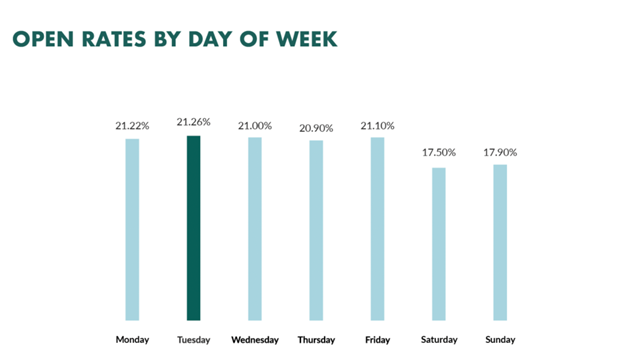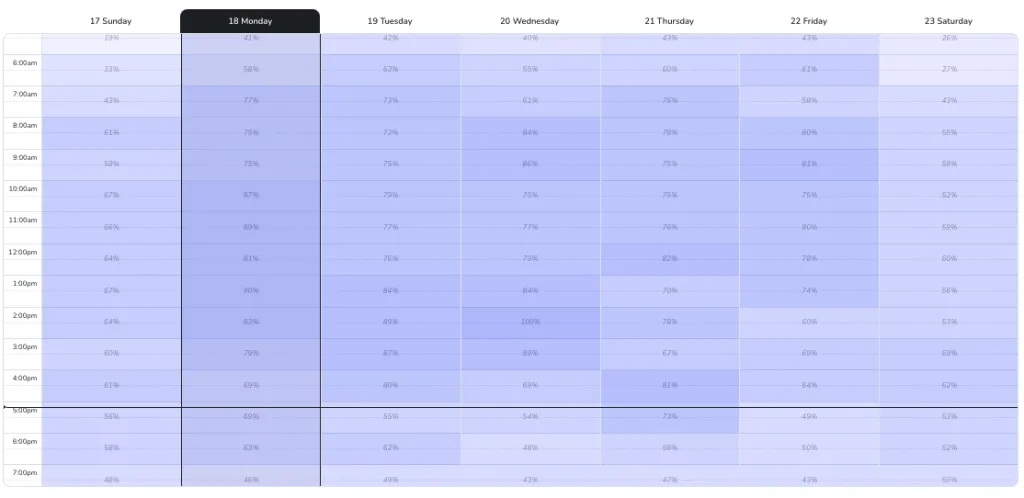Have you ever wondered why some marketing emails catch your attention while others get ignored? Timing plays a bigger role than you might think.
Especially on a busy day like Wednesday, sending your email at the right moment can make all the difference. If you want your message to stand out and get the response you’re aiming for, knowing the best time to hit “send” is key.
Keep reading to discover the exact window that can boost your open rates and turn your marketing emails into powerful tools for success.

Credit: www.mediamister.com
Why Timing Matters
Timing plays a key role in email marketing success. Sending emails at the right moment helps grab attention. It affects how many people open and engage with your message. Knowing when your audience is most active can make your campaigns more effective.
Impact On Open Rates
Email open rates depend heavily on timing. Emails sent during busy hours often get ignored. Sending on Wednesday at the right time increases the chance of being seen. Mid-morning or early afternoon usually works well. This is when people check their inboxes more often.
Effect On Click-through Rates
Click-through rates rise with well-timed emails. If readers open the email at a convenient time, they click links more. Timing affects how interested and ready they are to act. Choosing the right hour on Wednesday boosts engagement and response.
Avoiding Inbox Clutter
Many emails crowd inboxes on weekdays. Sending your email when fewer messages arrive helps it stand out. Mid-week, mid-day slots often face less competition. This reduces the chance your email gets lost or deleted unread.
Wednesday Email Trends
Wednesday stands out in the week as a key day for email marketing. Many people have settled into their workweek by Wednesday. This creates a good chance to catch their attention with marketing emails. Understanding the trends of email engagement on this day can help improve open rates and click-through rates.
Midweek Engagement Patterns
On Wednesday, email engagement tends to peak mid-morning. Around 10 AM is when many users check their inboxes. This time works well before lunch breaks interrupt their focus. Engagement drops slightly in the early afternoon. Sending emails in the morning can reach more active readers. People often clear their inboxes before the day’s second half.
Comparing Weekday Performance
Emails sent on Wednesday often perform better than Monday or Friday emails. Mondays can be overwhelming with new tasks. Fridays see less engagement as people prepare for the weekend. Tuesday and Wednesday emails get more attention and clicks. Wednesday has a balance of work momentum and user availability. This makes it a strong choice for email campaigns.
Industry-specific Insights
Different industries see varied results on Wednesday. Retail emails show higher engagement late morning. B2B emails get more responses mid-morning to early afternoon. Healthcare emails perform well around lunchtime. Timing may shift slightly based on audience habits. Testing your own audience’s response on Wednesday is important.
Best Time Slots On Wednesday
Choosing the right time to send marketing emails on Wednesday can boost your open rates. Email activity varies throughout the day. Knowing the best time slots helps reach more readers and get better responses.
Wednesday is a midweek day when people check emails during breaks or before starting tasks. Timing your emails to fit these habits can improve engagement. The key is to find when your audience is most likely to read your message.
Early Morning Hours
Sending emails between 6 AM and 8 AM captures early risers. Many check emails right after waking up or during their commute. Emails sent early stand a good chance of being seen first. This time slot works well for professionals and busy individuals.
Late Morning Peak
The period from 10 AM to 11 AM is prime for email opens. People have settled into their workday and often check emails before lunch. This slot catches readers when they are focused but not yet overwhelmed. It suits both B2B and B2C campaigns.
Afternoon Opportunities
Emails sent between 1 PM and 3 PM tap into afternoon breaks. Readers often scan their inbox after lunch to plan the rest of their day. This window offers a chance to engage those who missed morning emails. It works well for reminders and follow-ups.
Audience Behavior Factors
Understanding audience behavior is key to picking the best time to send emails on Wednesday. Each group of readers acts differently based on many factors. These behaviors affect how and when they open emails. Knowing these details helps improve email open rates and engagement.
Time Zones Impact
People live in different time zones. Sending emails at the same time might reach some during work hours. Others might get them too early or too late. Adjusting email schedules for time zones ensures emails arrive at the right moment. This leads to better chances of being read.
Work Schedule Considerations
Many people follow typical work hours, usually 9 a.m. to 5 p.m. Emails sent during breaks or just before work starts tend to get more attention. Mid-morning or early afternoon on Wednesday often works well. Avoid sending emails when people are too busy or about to leave work.
Mobile Vs Desktop Usage
Readers check emails on phones and computers. Mobile users often read emails during short breaks or while commuting. Desktop users open emails mostly at their desks. Knowing which device your audience uses helps choose the best sending time. This improves the chance your email gets noticed quickly.
Testing And Optimization
Testing and optimization are crucial for finding the best time to send marketing emails on Wednesday. Without testing, you rely on guesswork. Testing helps discover what works best for your audience. Optimization improves your email results over time.
A/b Testing Timing
A/B testing means sending two versions of an email at different times. One group gets the email early in the morning. Another group receives it in the afternoon. Compare which time gets more opens and clicks. Testing different times on Wednesday reveals the best moment to send.
Analyzing Performance Metrics
Look at open rates, click rates, and conversions. These numbers show how well your email performs. Track these metrics for each test time. Use data to understand which time gets the most attention. Good metrics guide your next steps.
Adjusting Based On Results
Change your email send times based on test results. If morning emails get more opens, send early. If afternoon emails get better clicks, adjust accordingly. Keep testing regularly to stay updated. Small changes can improve results over time.

Credit: www.superoffice.com
Tools To Schedule Emails
Scheduling emails is key to reaching your audience at the right moment. It helps you plan your message for when readers are most active. Using the right tools makes this task easier and more effective. These tools let you set exact times to send emails without manual work. They also help manage large email lists smoothly. Choosing the right tool can boost your email marketing success.
Popular Email Marketing Platforms
Many platforms offer built-in scheduling features. Mailchimp, Constant Contact, and Sendinblue are common choices. They allow users to pick specific dates and times for emails. These platforms are user-friendly and suit beginners well. You can save drafts and schedule them for any Wednesday. This makes email timing simple and organized.
Automation Features
Automation saves time by sending emails automatically. You can set rules based on user actions or time zones. For example, emails can go out at 10 AM every Wednesday. Some tools allow drip campaigns that send emails in a sequence. Automation ensures your emails land exactly when you want. It reduces the need to remember manual sending.
Integration With Analytics
Good scheduling tools link with analytics to track results. You can see open rates, click rates, and engagement stats. This data helps find the best time to send emails on Wednesdays. Insights from analytics improve future email schedules. Knowing when your audience is active leads to better responses.
Common Mistakes To Avoid
Many marketers make avoidable mistakes when sending emails on Wednesday. These errors hurt open rates and engagement. Knowing what to skip helps improve results.
Here are common mistakes to avoid for better email timing on Wednesday.
Sending Too Early Or Late
Sending emails too early may catch people before they check messages. Too late, and emails get lost in the day’s rush. Aim for mid-morning or early afternoon. This timing fits most work schedules and inbox checks.
Ignoring Audience Preferences
Not all audiences behave the same. Some prefer emails before lunch, others after work. Study your list’s habits and tailor send times. Ignoring preferences lowers open rates and trust.
Overlooking Frequency
Sending too many emails on Wednesday can annoy subscribers. Too few and they forget your brand. Find a balance. Consistent, well-timed emails keep your audience engaged without overwhelming them.

Credit: metricool.com
Frequently Asked Questions
What Is The Best Time To Send Marketing Emails On Wednesday?
The best time to send marketing emails on Wednesday is between 10 AM and 11 AM. This window captures mid-morning attention when recipients are actively checking emails. Avoid early mornings and late afternoons for better open rates and engagement.
Why Is Mid-morning Ideal For Wednesday Emails?
Mid-morning is ideal because recipients have settled into their workday. They are more likely to check and respond to emails during this time. Sending emails at mid-morning increases the chances of your message being noticed and acted upon.
Should I Avoid Sending Emails Late On Wednesday?
Yes, avoid sending emails late on Wednesday. Email engagement typically drops after 3 PM. Recipients often prepare to wrap up their day, reducing the likelihood of prompt email responses.
How Does Wednesday Email Timing Affect Open Rates?
Email timing on Wednesday significantly impacts open rates. Emails sent mid-morning see higher open rates. Proper timing aligns with recipient behavior and increases marketing effectiveness.
Conclusion
Choosing the right time on Wednesday boosts email success. Mid-morning and early afternoon show the best results. Avoid sending too early or too late in the day. Test different times to find what suits your audience best. Consistency helps your readers know when to expect your emails.
Keep your message clear and relevant for better engagement. Small changes in timing can improve open rates. Remember, understanding your audience is key. Use these tips to send emails that get noticed on Wednesdays.
